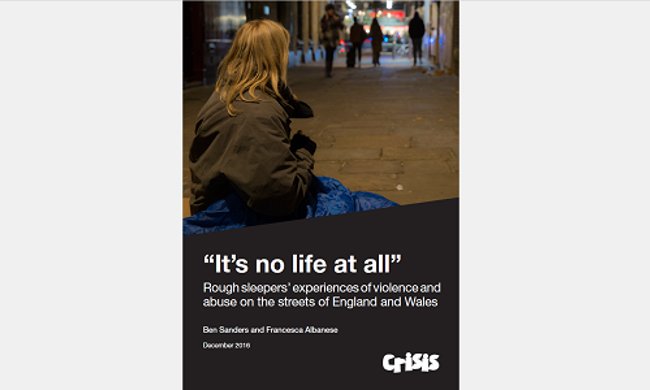It's No Life At All (2016)
05.04.2016
A survey of over 450 current and recent rough sleepers across England and Wales shows the high levels of abuse and violence experienced by people we spoke to and the impact this has on their health and wellbeing.
Key findings
Overall homelessness is increasing in England, and there has been a sharp upward trend in the most visible form of homelessness – rough sleeping. This report presents the findings from a face-to-face survey with 458 homeless people who had experienced rough sleeping across England and Wales in the 12 months prior to the research taking place. The research was undertaken in response to the growing concern around the treatment and potential victimisation of people experiencing street homelessness. The findings below show the high levels of abuse and violence experienced by people we spoke to and the impact this has on their health and wellbeing.
- The survey reveals the shocking scale of violence and abuse faced regularly by rough sleepers in England and Wales. Seventy seven per cent (353) of survey respondents reported anti-social behaviour and/or crime against them in the past 12 months.
- The majority (66%/302) of respondents think life on the street is getting worse.
- Three in ten (30%/139) rough sleepers reported being deliberately hit or kicked or experiencing another form of violence in the past 12 months (women proportionally more).
- Six per cent of respondents (25) had been sexually assaulted in the past 12 months.
- Furthermore, almost half (45%/206) of current or recent rough sleepers surveyed said they had been intimidated, or threatened with violence or force. Thirty per cent (31%/141) had had things thrown at them and in seven per cent (33) of cases rough sleepers had been urinated on.
- Adding to these experiences is the verbal abuse rough sleepers received. This was the most common form of anti-social behaviour experienced; with over half of respondents (56%/254) being verbally abused or harassed.
- Damage to, and theft of, their personal property was also commonly experienced. More than half (51%/234) of recent and current rough sleepers surveyed reported having personal belongings stolen. Deliberate damage or having personal items vandalised was experienced by 20 per cent (91).
- Members of the public, who the survey respondents did not know, were the leading perpetrators of incidences of violence and abuse. Perhaps equally troubling is that over half (53%/157) of the latest incidences of abuse and violence rough sleepers had experienced were unreported to the police. The main reason for this was due to the expectation that nothing would be done by the police.
- In-depth interviews with people experiencing crime and anti-social behaviour further highlighted the impact and consequences of these experiences. Rough sleepers reported how living on the streets meant living in fear and having to navigate constant risk and uncertainty about their safety. This was largely caused by the dilemma of who to trust and whether to remain hidden or close to busy areas.
- Fear and isolation affected rough sleepers’ health and wellbeing. Those who shared their experiences with us often linked the incidences that took place with negative patterns of behaviour such as alcohol and drug abuse. For some people their experience of rough sleeping also affected their physical health.
- For many people who took part in the survey and interviews, their experiences took a toll on their mental wellbeing pushing some to question the relevance of their existence and undermining their confidence to move on from their circumstances.
Reference
Sanders, B. & Albanese, F. (2016) “It’s no life at all”: Rough sleepers’ experiences of violence and abuse on the streets of England and Wales. London: Crisis.
Downloads

It's No Life At All (PDF)
Survey of over 450 current and recent rough sleepers across England and Wales.
